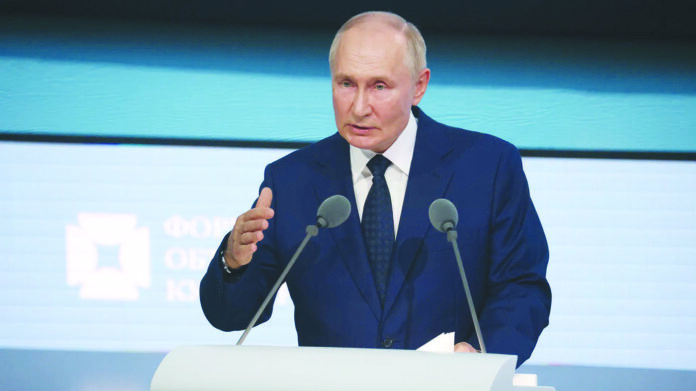Over two and a half years ago, Russia launched a military invasion into Ukraine, a nation that was once part of the Russian Empire and later the USSR. The reasons behind this invasion were deeply rooted in geostrategic considerations. Russia, historically wary of threats from its western and southern borders, perceived Ukraine as a critical buffer state. Moscow’s concern was not solely based on contemporary threats but also on historical precedents. Both Napoleon and Hitler had invaded Russia through its western front, and the lack of strategic depth in these areas had made it vulnerable.
Thus, for Russia, maintaining control or significant influence over Ukraine was a matter of national security. Russia’s invasion was driven by the need to prevent what it saw as the possibility of a hostile force using Ukraine as a staging ground for an attack. Even if no immediate invasion plans existed from the West, the Kremlin’s geopolitical strategy required preparing for a worst-case scenario. Geopolitics often demands a proactive approach, wherein states prepare for potential threats long before they manifest.
For Moscow, the presence of a pro-Western government in Kyiv was a signal that the West was inching closer to Russia’s sphere of influence. This concern was exacerbated by events in 2014, when a pro-Russian president of Ukraine was ousted following a popular uprising, which Moscow believed had Western backing. For Russia, this represented a shift towards Western encroachment, heightening fears of a broader strategy to weaken or encircle it.
The West’s apprehensions were also based on historical and contemporary analyses. Many Western nations feared that Russia’s invasion of Ukraine could set a precedent for further aggression, potentially threatening other parts of Europe. The mutual fear and suspicion between Russia and the West were not entirely irrational; both sides had strategic concerns that, over time, seemed to validate each other’s fears. Russia, seeking to safeguard its borders, and the West, aiming to deter potential Russian expansionism, ended up in a state of strategic opposition.
The early days of the invasion were marked by a bold but flawed strategy. Russia aimed to execute a rapid assault, deploying tank columns on multiple fronts to instil panic and quickly overpower Ukrainian forces. The logic behind this manoeuvre was to swiftly neutralize Ukrainian resistance, thereby discouraging foreign intervention, particularly from the USA and NATO.
However, the execution of this plan proved problematic. The infamous 40-kilometer-long column of Russian tanks heading towards Kyiv from the north became a symbol of strategic failure. Despite the imposing visual of Russian military hardware, these columns faced logistical issues, with inadequate supplies of fuel and ammunition. The tanks stalled, creating an opportunity for Ukrainian forces to pick off Russian units from the front and rear, effectively immobilizing the column.
This marked the first major setback for Russia. Ukraine’s defensive strategy capitalized on these missteps. Unlike conventional warfare, which would involve massing troops to confront an invading force, Ukraine deployed small, mobile units that could strike Russian positions opportunistically. This agile, decentralized approach disrupted Russia’s plans, making it difficult for the invading forces to maintain cohesive advances.
Russia’s failure to decisively crush Ukrainian resistance has left it in a precarious position. The prolonged nature of the conflict, combined with international sanctions and diplomatic isolation, has strained its resources. If Russia continues to prioritize city capture without addressing the broader strategic need to neutralize Ukrainian forces, it risks further setbacks. To prevent more failures, Moscow will need to adapt its strategy, possibly by fortifying defensive positions and reconsidering its offensive tactics.
Ukraine’s resistance, combined with logistical failures on Russia’s part, undermined the Kremlin’s hope of a swift and decisive victory. Russia’s strategy was further hampered by several key intelligence miscalculations. Moscow did not anticipate the extent of US and European involvement.
Washington, with its extensive experience in proxy conflicts, decided against deploying American troops directly but provided significant military aid to Ukraine. This included the supply of advanced weaponry, intelligence sharing, and logistical support, all aimed at blunting Russian advances. The US. saw this as an opportunity to weaken Russia’s military capabilities without engaging in direct combat, a tactic that had been effective in past conflicts such as in Afghanistan during the Soviet invasion.
Another major miscalculation was Russia’s overestimation of Europe’s dependence on its energy supplies. It assumed that Europe, especially Germany, would be reluctant to jeopardize their economic ties with Russia, leading to minimal cooperation with NATO efforts. However, European nations demonstrated resilience and adaptability. Germany and other countries sought alternative energy sources, accelerated their transition to renewable energy, and remained aligned with NATO’s strategic objectives. While energy constraints posed significant challenges, the collective resolve of European nations to find alternatives and reduce dependency on Russian oil and gas represented a strategic misjudgment by the Kremlin.
One of the critical aspects that Moscow misread was Ukraine’s military strategy. Ukrainian forces adopted a strategy of flexibility and adaptability. They avoided large-scale confrontations, which would have made them vulnerable to Russia’s superior firepower.
Instead, Ukrainian units focused on ambushes, guerrilla tactics, and quick, mobile strikes that disrupted Russian supply lines and forced Russian units into defensive positions. This decentralized approach was successful because it allowed Ukrainian forces to exploit the vulnerabilities in Russia’s logistical and strategic planning.
From a strategic standpoint, Russia’s initial objective seemed to prioritize the rapid capture of major Ukrainian cities, including Kyiv. However, this approach was resource-intensive and overlooked the complexities of urban warfare. Capturing a city does not equate to controlling it, as evidenced by the prolonged conflicts in urban settings throughout modern history. Russia’s inability to secure decisive victories in cities like Kyiv, Kharkiv, and Mariupol revealed the limitations of its approach.
While Russia managed to take control of some parts of eastern Ukraine, these gains were not sufficient to achieve a definitive strategic victory. Compounding Russia’s strategic difficulties was the decision to deploy the Wagner Group, a private mercenary organization, to the battlefield. Traditionally, mercenary groups serve supplementary roles, providing additional manpower or engaging in operations that are not suitable for conventional forces.
However, the Kremlin’s reliance on Wagner blurred the lines between state and private military functions. Wagner’s operations became a focal point of internal power struggles, particularly regarding ammunition distribution and command hierarchy. President Vladimir Putin’s apparent preference for Wagner over conventional Russian military command exacerbated tensions, leading to an attempted insurrection by Wagner’s leader, Yevgeny Prigozhin.
Prigozhin’s rebellion, which was quickly quelled, nonetheless exposed fractures within Russia’s military apparatus. The subsequent death of Prigozhin in a plane crash was widely interpreted as a consolidation of control by the Kremlin, but it also highlighted the extent of internal discord. The fallout from this incident weakened the cohesion of Russia’s military command, further complicating efforts to implement a coherent and unified strategy.
In the wake of these strategic failures, Russia’s military command has had to reconsider its approach. Moscow initially sought to achieve rapid victories by capturing major cities, but this has not yielded the desired outcomes. The Ukrainian counteroffensive, marked by a surprising invasion into Russian territory, signalled a shift in the dynamics of the conflict. Ukraine’s ability to mount offensives into Russian border areas reflected the strategic limitations that Russia faces, including stretched supply lines and vulnerable logistical nodes.
Russia’s failure to decisively crush Ukrainian resistance has left it in a precarious position. The prolonged nature of the conflict, combined with international sanctions and diplomatic isolation, has strained its resources. If Russia continues to prioritize city capture without addressing the broader strategic need to neutralize Ukrainian forces, it risks further setbacks. To prevent more failures, Moscow will need to adapt its strategy, possibly by fortifying defensive positions and reconsidering its offensive tactics.






















